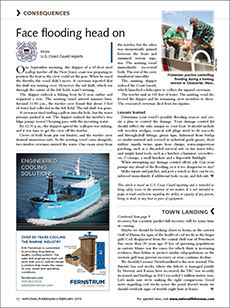Face flooding head on
One September morning, the skipper of a 65-foot steel scallop trawler off the New Jersey coast was preparing to position the boat so the crew could set the gear. When he eased the throttle, the vessel didn’t move. A crewman reported that the shaft was turning over. However, the tail shaft, which ran through the center of the fish hold, wasn’t turning.
The skipper radioed a fishing boat he’d seen earlier and requested a tow. The assisting vessel arrived minutes later. Around 11:50 a.m., the trawler crew found that about 3 feet of water had collected in the fish hold. The tail shaft was gone.
A crewman tried stuffing a pillow into the hole, but the water pressure pushed it out. The skipper realized the trawler’s two bilge pumps weren’t keeping pace with the incoming water.
By 12:30 p.m., the skippers agreed the scalloper was sinking, and it was time to get the crew off the trawler.
Crews of both boats put out fenders, and the trawler crew donned immersion suits. As the assisting vessel came alongside, two trawler crewmen entered the water. One swam away from the trawler, but the other was momentarily pinned between the boats and sustained serious injuries. The assisting vessel immediately recovered both. The rest of the crew transferred smoothly.
The assisting skipper radioed the Coast Guard, which launched a helicopter to collect the injured crewman.
The trawler sank in 145 feet of water. The assisting vessel delivered the skipper and his remaining crew members to shore. The evacuated crewman died from his injuries.
Lessons learned
Determine your vessel’s possible flooding sources and create a plan to control the damage. Your damage control kit should reflect the risks unique to your boat. It should include soft wooden wedges; conical soft plugs sized to fit seacocks and through-hull fittings; grease tape, fashioned from burlap or similar material and covered in industrial grade grease; sheet rubber; manila twine; spare hose clamps; water-impervious patching, such as a discarded survival suit or tire inner tube; and simple hand tools, such as a hatchet, a hammer, screwdrivers, C-clamps, a small handsaw and a disposable flashlight.
When attempting any damage control effort, ask: Can your pumps stay ahead of the flooding, or is it too dangerous to stay?
Make repairs and patches, and post a watch so they can be reinforced immediately if additional leaks occur, and fish safe.
This article is based on U.S. Coast Guard reporting and is intended to bring safety issues to the attention of our readers. It is not intended to judge or reach conclusions regarding the ability or capacity of any person, living or dead, or any boat or piece of equipment.








